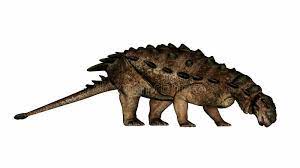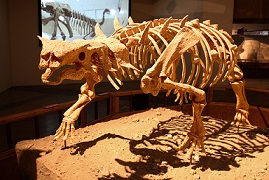
Pinacosaurus is a genus of ankylosaurian dinosaur that lived during the Late Cretaceous period, approximately 84 to 71 million years ago. It belongs to the family Ankylosauridae, which is known for its armored dinosaurs characterized by their thick bony plates and club-like tails.
The name Pinacosaurus means plank lizard and reflects the dinosaur's heavily armored appearance. Fossils of Pinacosaurus have been discovered in what is now Mongolia and China, particularly in the famous Djadokhta Formation.
| Name: | Pinacosaurus dinosaurs |
| Size: | Around length:13 to 16 feet,weight:1 to 2 tons . |
| Main Facts: | Pinacosaurus, a Late Cretaceous herbivore, is renowned for its distinctive armor and a formidable tail club, used for self-defense. |
Pinacosaurus boasted an unmistakable armored physique. Its body was covered in thick bony plates, known as osteoderms, which served as a protective shield against predators. Its low-slung, quadrupedal stance and broad, flat head were hallmarks of ankylosaurid anatomy.

One of Pinacosaurus's most distinctive features was its tail club, a formidable weapon. This club was composed of fused vertebrae and could be wielded as a defensive tool against threats, underscoring the importance of self-preservation in the Late Cretaceous arms race
Despite its armor and defensive capabilities, Pinacosaurus was a herbivore. It dined on low-lying vegetation, likely including cycads, ferns, and other plants adapted to the Late Cretaceous landscape. Its dental adaptations were suited for processing fibrous plant material.
Pinacosaurus inhabited an ecosystem teeming with diverse dinosaurs, from the swift Velociraptors to the herbivorous Protoceratops. The complex interactions among these creatures, including predator-prey dynamics, provide a window into the ecological intricacies of the Late Cretaceous.
Our knowledge of Pinacosaurus is shaped by fossil discoveries, but like many ancient creatures, the fossil record remains incomplete. Taxonomists have identified multiple species within the genus, highlighting the complexities of classifying these prehistoric animals.
Pinacosaurus contributes to our understanding of Late Cretaceous ecosystems and the evolutionary adaptations of ankylosaurid dinosaurs. Its armored physique and tail club offer insights into the strategies these creatures employed for survival.
Pinacosaurus, a Late Cretaceous ankylosaurid dinosaur, was a formidable armored herbivore that thrived in ancient Asia, particularly Mongolia and China. Its distinctive features included a body encased in bony plates, offering protection against predators, and a tail club, used both defensively and potentially offensively.This dinosaur's relatively compact size, about 13 to 16 feet in length and weighing around 1 to 2 tons, made it a robust and well-armored presence in its ecosystem. Its diet primarily consisted of low-lying vegetation, such as ferns and cycads, making it a herbivorous browser.
Pinacosaurus coexisted with a diverse array of Late Cretaceous dinosaurs, ranging from fellow herbivores like Protoceratops to nimble predators like Velociraptors. Its role in these prehistoric ecosystems was that of a sturdy, heavily armored guardian, defending itself against potential threats.As a sentinel from the past, Pinacosaurus reminds us of the fascinating diversity of dinosaurs that once roamed our planet. Its armor, weaponry, and herbivorous habits provide a captivating glimpse into the complex interactions that shaped ancient environments during the Late Cretaceous.
Pinacosaurus belonged to the ankylosaurid family, known for their extensive armor. Comparing it to other ankylosaurids like Ankylosaurus reveals variations in armor arrangement and body size.
The presence of a tail club in Pinacosaurus is a striking feature. Contrasting it with ankylosaurids lacking tail clubs showcases the diverse defensive adaptations within this group.
Pinacosaurus, as an herbivore, had a different diet than carnivorous dinosaurs like Velociraptors. Comparing their feeding strategies and adaptations highlights the diverse ecological roles within Late Cretaceous ecosystems.
Pinacosaurus fossils were found in Asia, while some ankylosaurids, such as Ankylosaurus, were discovered in North America. This geographic distinction suggests separate populations and potentially distinct species.
Contrasting Pinacosaurus's use of the tail club for defense with the potential offensive role of tail clubs in some ankylosaurids underscores the versatility of this adaptation.
Pinacosaurus lived alongside predators like Velociraptors and Theropods. Comparing its armor and defenses to the hunting strategies of these carnivores provides insights into predator-prey interactions.
Examining Pinacosaurus alongside other Late Cretaceous dinosaurs like Protoceratops and Gallimimus illuminates the complex web of life in this period, encompassing herbivores, omnivores, and carnivores.
Pinacosaurus, like many dinosaurs, is still subject to ongoing research. Comparing it to other ankylosaurids contributes to a deeper understanding of their evolution and adaptations.